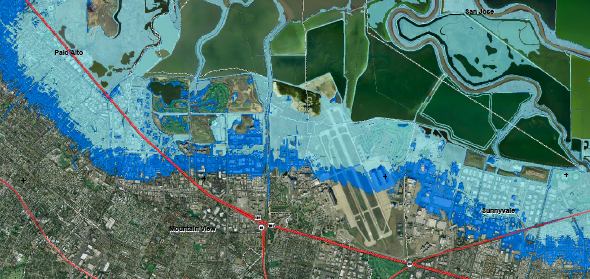Did you know that Sun and Google headquarters may be below sea level?
California published today its comprehensive risk assessment of coastline vulnerabilities to rising sea levels caused by climate change. It paints a tough future that will require extensive adaptation, from Los Angeles to Silicon Valley. The state is the first in the nation to complete a study of this magnitude.
While my job as a reporter at Circle of Blue usually entails documenting a global water crisis and declining fresh water levels, our colleagues over at the Pacific Institute prepared the sobering report about rising seas. It says San Francisco will be hardest hit.
Here are key paragraphs from the San Francisco Chronicle:
SAN FRANCISCO -- Driven by global warming, the ocean is expected to rise nearly 5 feet along California's coastline by the end of the century, hitting San Francisco Bay the hardest of all, according to a state study released today.
Nearly half a million people and $100 billion in property, two-thirds of it concentrated around the bay, are at risk of major flooding, researchers found in the most comprehensive study to date of how climate change will alter the state's coastal areas.
Rising seas, storms and extreme high tides are expected to send saltwater into low-lying areas, flooding freeways, the Oakland and San Francisco airports, hospitals, power plants, schools and sewage plants. Thousands of structures at risk are homes of low- and middle-income people, the study said.
Vast wetlands that nourish fish and birds and act as a buffer against flooding will be inundated and could turn into dead pools. Constructing seawalls and levees, if needed, could cost $14 billion plus an annual maintenance cost of $1.4 billion, the study said.

Palo Alto and Mountain View -projected sea level
Is there any good news? Maybe a tiny bit.
It was nearly four years ago that Duke University's Nicholas Institute and the Aspen Institute convened a group of journalists to find new ways to talk about the "slow-fuse" issues like water scarcity, climate change and energy use. Together we lamented our industry's short attention span, particularly for what were emerging as the most important stories of the century.
Journalism faces a particularly difficult challenge in covering issues, like the environment, that are scientifically complex. Such issues often develop slowly and have critically important long-term consequences but few specific news pegs that are necessary to compete against other stories for limited news space or broadcast minutes.
Slow Fuse: Journalistic Approaches to Climate Change
Toss in the decline in newsrooms across the country, and we have a veritable news vacuum.
But to see science reportage untainted by ideological debate and advance thinking from California is refreshing even if the information is hard to bear (or even imagine). And there are more studies to come from Schwarzenegger's Climate Action Team that most certainly won't be cheery.
It occurred to me that maybe these are clear signs that the public, the press and our leadership are now ready to take head-on these major global challenges.
Heed the science.
We can handle the truth.